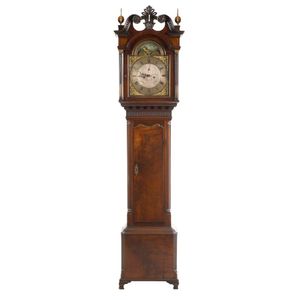Mahogany Longcase Clock by John Aspinwall, Liverpool, circa 1800
You must be a subscriber, and be logged in to view price and dealer details.
Subscribe Now to view actual auction price for this item
When you subscribe, you have the option of setting the currency in which to display prices to $Au, $US, $NZ or Stg.
- Circa - A Latin term meaning 'about', often used in the antique trade to give an approximate date for the piece, usually considered to be five years on either side of the circa year. Thus, circa 1900 means the piece was made about 1900, probably between 1895 and 1905. The expression is sometimes abbreviated to c.1900.
- Finial - An architectural decoration, found on the upper parts of of an object. On furniture they are usually found on pediments, canopies and shelf supports. On smaller ceramic or silver items, such as spoons, they may decorate the top of the item itself, or the lid or cover where they provide a useful handle for removal.
Finials have a variety of shapes and forms. They may be urn-shaped, baluster shaped round or spiral, but usually taper into an upper point. Many real life shapes may also be used as finials, such as pineapples, berries, pinecones, buds, lotus and acorns. Sometimes animals such as a lion are depicted, or fish and dolphins. - Hood - In longcase clocks, the hood is the wooden case that surrounds the works and dial, and includes the glass front, which is usually hinged, so the door can be opened to wind the clock or adjust the time. In 18th and 19th century longcase clocks the hood usually slides forward for removal, allowing access to the works.
- Foliate - Decorated with leaves or leaf-like forms.
- Mahogany - Mahogany is a dense, close grained red-coloured timber from the West Indies and Central America. It was first imported into Europe in the the early 18th century and its use continued through the 19th century. It was popular for furniture making because of its strength, the wide boards available, the distinctive grain on some boards, termed flame mahogany and the rich warm colour of the timber when it was polished.. The "flame" was produced where a limb grew out from the trunk of the tree, and this timber was usually sliced into veneers for feature panels on doors, backs and cornices.
Some terms used to describe mahogany relate to the country from which it originally came, such as "Cuban" mahogany, "Honduras" mahogany etc. However unless the wood has been tested the names assigned are more a selling feature, rather than a true indication of the timber's origin. - Spandrel - An architectural term that in horology refers to the triangular ornamental decoration in the corners of of the dial plate. The spandrels are usually of cast brass and may be additonally chased and engraved. On painted dial clocks the spandrels are also usually painted.
This item has been included into following indexes:
Visually similar items

A mahogany longcase clock by Percival Mann, London, circa 1790, contained within a mahogany case the swan neck pediment carved with fret work and rosettes, the hood and case with reeded pilasters, the glazed hood enclosing an arch dial with moon face marke

A 19th century mahogany cased long case clock with a painted Roman numeral moon phase dial, subsidiary seconds dial and calendar, the eight day bell striking movement with an anchor escapement housed in a break arch hood, the shaped rectangular casement do

A George III William Wilkinson of London quality mahogany longcase clock, the pagoda-type hood with reeded column supports enclosing the brass dial with silvered chapter ring, black enamelled Roman numerals, subsidiary seconds dial, date aperture, makers'

A George III style mahogany longcase clock the eight day movement with an anchor escapement, gong striking, with a silvered dial and subsidiaries for seconds, month and moon phase, housed within a mahogany case, 255 cm high
